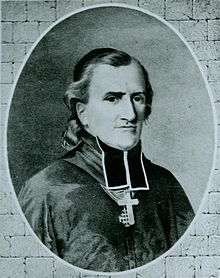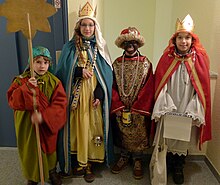Charles-Auguste-Marie-Joseph de Forbin-Janson
Charles-Auguste-Marie-Joseph de Forbin-Janson (born November 3, 1785 in Paris , France , † July 11, 1844 in Marseille ) was a French nobleman , Bishop of Nancy and founded the "Work of the Holy Childhood", now papal Children's Mission .
Origin and family
He came from the old French noble family of the Counts of Forbin, his parents were the officer and later general Michel Palamede de Forbin-Janson (1746-1832), as well as his wife Gabrielle von Gallean (1763-1834), daughter of Prince Karl Anton Hyacinth von Gallean (1737–1778), chief steward of the Palatinate Elector Karl Theodor . The grandfather Karl Anton Hyacinth von Gallean died in Mannheim in 1778 and is buried in the local parish church of St. Sebastian , where his epitaph made of black marble has been preserved. Through him, and after his death, the family had ties to Elector Karl-Theodor. When Charles-Theodore Palamede de Forbin-Janson (1783–1849), the older brother of Charles-Auguste-Marie-Joseph, was born in 1783, the Elector of the Palatinate acted as godfather. The boy later became chamberlain to Emperor Napoleon.
After the revolution broke out in France, the parents fled with their two sons to Electoral Palatinate Bavaria in 1790 under the protection of their friend, Elector Karl-Theodor. They also took their paternal grandfather, General Joseph Palamede de Forbin-Janson with them, who settled permanently in Heidelberg , died there in 1809 and was buried in the then still Catholic choir of the Heiliggeist Church , where a marble epitaph was dedicated to him.
Live and act
The family - except for the grandfather - went back to France under Napoleon . Charles-Auguste-Marie-Joseph de Forbin-Janson entered the Conseil d'État as an auditor in 1805 . Because of the violent measures taken by the emperor against the church and the pope at the time, Forbin-Janson decided to leave the civil service to become a clergyman. From 1808 he attended the Saint-Sulpice seminary in Paris , where he made friends with the seminarian Eugene von Mazenod . Both were enthusiastic about the missionary idea; Mazenod later became the founder of the Oblates of the Immaculate Virgin Mary and has been a Saint of the Catholic Church since 1995 .
Forbin-Janson received in the December 15, 1811 Chambery the priesthood . He then became superior of the local diocesan seminary. In 1814 he went to Rome to submit his mission plans for China to Pope Pius VII . The pontiff urged the nobles to give up the project and determined him to take part in the new evangelization of France. On his return he founded on the papal mandate with Abbé David de Rauzan the Société des Missions de France , which had its headquarters on Mont Valérien near Paris. Later the religious community called itself " Priests of Mercy ".
For almost 10 years, Charles-Auguste-Marie-Joseph de Forbin-Janson worked with great zeal on the new missionary work in his homeland, when he was called on November 21, 1823 as Bishop of Nancy and Primate of Lorraine; He was ordained bishop on June 6, 1824, Gustav Maximilian von Croÿ , Archbishop of Rouen ; Co - consecrators were Jean-Louis Anne Madelain Lefebvre de Cheverus , the Bishop of Montauban , and Bishop Louis-Sylvestre de La Châtre . Forbin-Janson was known as a dedicated supporter of King Charles X , which is why insurgents raided his seat during the July Revolution of 1830 . The bishop was currently on a company tour , but was prevented from returning and resuming his office permanently by the new ruler Louis-Philippe I. He elected the future Cardinal François-Auguste-Ferdinand Donnet (1795–1882) to be his diocesan representative and coadjutor , to whom he himself donated the episcopal ordination in 1835. In 1839 he also consecrated the future Cardinal-Archbishop of Paris, François-Nicolas-Madeleine Morlot .
He had now become the head shepherd without a seat and was traveling about. Forbin-Janson has worshiped, given sacraments, and held retreats wherever he was needed . Eventually a mission plan matured in him again. He had received invitations from French-speaking clergy from the USA and Canada and wanted to work there as a mission bishop. So he went to Rome, where Pope Gregory XVI. supported his project and officially entrusted him with missionary work in North America.
On October 18, 1839, Charles-Auguste-Marie-Joseph de Forbin-Janson arrived in New York . He was active in various cities and attended the 4th Provincial Council of Baltimore in May 1840 . In September of that year he went to Canada, where he also visited various cities. In Quebec Cathedral he held a two-week retreat with a daily sermon, each time attended by around 5,000 people. In 1841 he had a cross 100 feet high, visible from afar, erected on Mont Saint-Hilaire . On December 8th of that year Forbin-Janson drove back to Europe from New York. In January 1842 he arrived in Rome. Gregory XVI. appointed him because of his services to the papal assistant throne and gave him the dignity of a Roman count . As a former follower of Charles X, he was still prevented from exercising his episcopal office by King Luis Philippe; he refused a voluntary resignation.
When he returned from Rome, he made the plan to start a ministry from children for children. French children should pray and work in favor of proselytizing Chinese children. He wanted to affiliate this work to the "Oeuvre de la Propagation de la Foi" (Lyon Mission Society) founded in Lyon in 1822 , but there was no interest in it. That is why Charles-Auguste-Marie-Joseph de Forbin-Janson founded an independent institution on May 19, 1843, the "Papal Work of the Holy Childhood" , which soon spread beyond France and is known in Germany today as the Papal Children's Mission . In Germany it has been organizing the annual carol singing since 1959 , at which children and young people collect donations for children's aid projects all over the world.
From the start, Bishop Forbin-Janson was busy establishing and consolidating his new work in France and Belgium. To this end, he undertook various trips again, coming to southern France in the summer of 1844. There he died suddenly and unexpectedly in the castle of his brother Charles-Theodore Palamede, in Les Aygalades near Marseille. He was buried in the Picpus cemetery in Paris. The Société Saint-Jean-Baptiste (Association of French Canadians ) issued private charity stamps with the portrait of the bishop in 1944.
Apostolic succession
The Apostolic Succession from Bishop Forbin-Janson is documented up to Cardinal Scipione Rebiba :
- Bishop Charles-Auguste-Marie-Joseph de Forbin-Janson
- Cardinal Gustav Maximilian von Croÿ
- Archbishop Jean-Charles de Coucy
- Cardinal Antonio Dugnani
- Cardinal Carlo Rezzonico
- Cardinal Giovanni Francesco Albani
- Clement XIII.
- Benedict XIV.
- Benedict XIII.
- Cardinal Paluzzo Paluzzi Altieri degli Albertoni
- Cardinal Ulderico Carpegna
- Cardinal Luigi Caetani
- Cardinal Ludovico Ludovisi
- Archbishop Galeazzo Sanvitale
- Cardinal Girolamo Bernerio , OP
- Cardinal Giulio Antonio Santorio
- Cardinal Scipione Rebiba
literature
- Fernand Baldensperger : Melanges D'histoire Litteraire Generale Et Comparee. Volume 1, Geneva 1972, p. 229; limited preview in Google Book search
- Camillus Maes: Comte de Charles-Auguste-Marie-Joseph Forbin-Janson . In: Catholic Encyclopedia , Volume 6, Robert Appleton Company, New York 1909.
Web links
- Genealogical website on Charles-Auguste-Marie-Joseph de Forbin-Janson
- Family tree
- Biographical website
- Vatican website on ministries, with its own section on Bishop de Forbin-Janson
- Entry on Charles-Auguste-Marie-Joseph de Forbin-Janson on catholic-hierarchy.org ; accessed on November 16, 2016.
Individual evidence
- ^ Genealogical page on Charles-Theodore Palamede de Forbin Janson
- ↑ James Donohue: The Fathers of Mercy . In: Catholic Encyclopedia , Volume 5, Robert Appleton Company, New York 1909. on the history of the Order
- ^ Website of the Kindermissionswerk with mention of Bishop Forbin-Janson as founder
- ^ Website of the cemetery with a photo of the bishop's burial chapel
- ↑ Website showing the brands
| personal data | |
|---|---|
| SURNAME | Forbin-Janson, Charles-Auguste-Marie-Joseph de |
| ALTERNATIVE NAMES | Forbin-Janson, Charles de |
| BRIEF DESCRIPTION | French bishop, missionary, founder of a missionary organization |
| DATE OF BIRTH | November 3, 1785 |
| PLACE OF BIRTH | Paris , France |
| DATE OF DEATH | July 11, 1844 |
| Place of death | Marseille |


